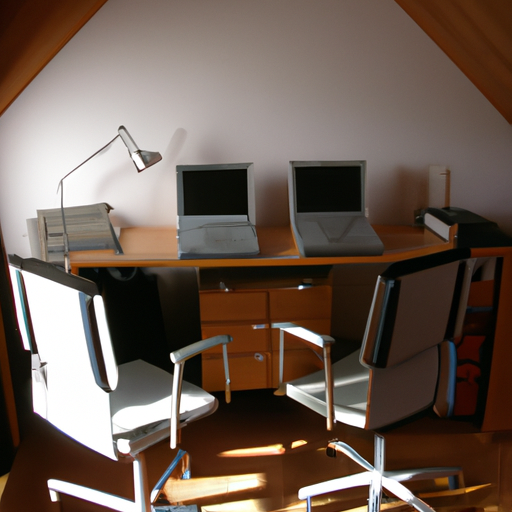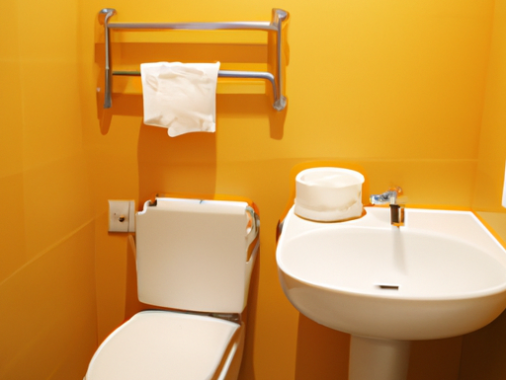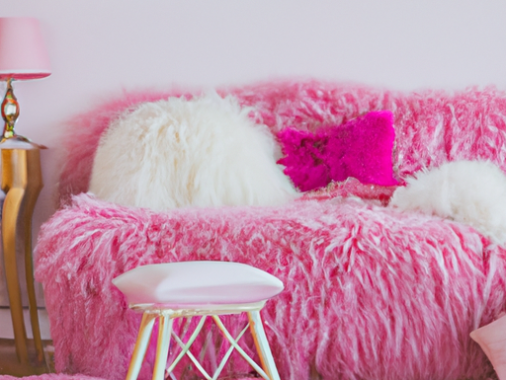-
Table of Contents
- Introduction
- How to Create a Productive Home Office Environment
- Tips for Maximizing Space in a Small Home Office
- The Benefits of Working from Home
- How to Set Up an Ergonomic Home Office
- The Best Home Office Gadgets for Increased Productivity
- How to Stay Organized in a Home Office
- How to Balance Work and Home Life When Working from Home
- Q&A
- Conclusion
Introduction
Welcome to the world of home office! Working from home has become increasingly popular in recent years, and for good reason. With the right setup, you can create a comfortable and productive workspace that allows you to get the job done without having to leave the house. Whether you’re a freelancer, a remote worker, or just someone who needs a dedicated space to focus on their work, a home office can be a great way to stay productive and organized. In this guide, we’ll discuss the basics of setting up a home office, from choosing the right furniture and equipment to creating a comfortable and inspiring environment. We’ll also provide tips on how to stay organized and productive while working from home. So let’s get started!
How to Create a Productive Home Office Environment
Creating a productive home office environment is essential for anyone who works from home. A productive home office environment can help you stay focused and organized, allowing you to get more done in less time. Here are some tips for creating a productive home office environment.
1. Choose the Right Space: The first step in creating a productive home office environment is to choose the right space. Make sure the space is comfortable and free from distractions. If possible, choose a room with natural light and plenty of space to move around.
2. Invest in Quality Furniture: Investing in quality furniture is essential for creating a productive home office environment. Choose furniture that is comfortable and ergonomic. Make sure the furniture is adjustable so you can adjust it to fit your needs.
3. Organize Your Space: A cluttered workspace can be distracting and make it difficult to focus. Take the time to organize your space and keep it tidy. Invest in storage solutions such as filing cabinets and shelves to keep your workspace organized.
4. Add Personal Touches: Adding personal touches to your workspace can help make it more inviting and comfortable. Consider adding plants, artwork, or photos to your workspace to make it feel more like home.
5. Utilize Technology: Technology can be a great tool for staying productive. Invest in a good computer, printer, and other office equipment to help you stay organized and efficient.
By following these tips, you can create a productive home office environment that will help you stay focused and productive. With the right space, furniture, and technology, you can create an environment that will help you get more done in less time.
Tips for Maximizing Space in a Small Home Office
1. Utilize vertical space: Make use of wall space by installing shelves and cabinets. This will help to keep your office organized and free up floor space.
2. Choose furniture that is multifunctional: Invest in furniture that can serve multiple purposes. For example, a desk with drawers can also be used as a filing cabinet.
3. Use a laptop instead of a desktop: Laptops are much smaller and take up less space than a desktop computer.
4. Utilize the corners: Corners are often overlooked when it comes to office design. Place a corner desk or a small filing cabinet in the corner to maximize space.
5. Use a wall-mounted monitor: Wall-mounted monitors are a great way to save space and keep your desk clutter-free.
6. Invest in a printer/scanner combo: A printer/scanner combo is a great way to save space and money.
7. Use a laptop stand: A laptop stand can help to keep your laptop off the desk and free up space.
8. Utilize storage bins: Storage bins are a great way to keep your office organized and free up space.
9. Use a standing desk: Standing desks are a great way to save space and keep your posture in check.
10. Hang items on the wall: Hang items such as calendars, whiteboards, and bulletin boards on the wall to save space.
The Benefits of Working from Home
Working from home has become increasingly popular in recent years, and for good reason. There are many benefits to working from home, including increased flexibility, improved work-life balance, and cost savings.
Flexibility is one of the primary benefits of working from home. Employees can set their own hours and work when it is most convenient for them. This can be especially beneficial for those with family commitments or other obligations that make it difficult to work a traditional nine-to-five job. Working from home also allows employees to take breaks when needed and work in a comfortable environment.
Another benefit of working from home is improved work-life balance. Working from home allows employees to spend more time with family and friends, as well as pursue hobbies and interests. This can lead to increased job satisfaction and improved mental health.
Finally, working from home can save money. Employees can save on commuting costs, as well as the cost of meals and other expenses associated with working in an office. Additionally, employers can save on overhead costs, such as office space and equipment.
In conclusion, working from home has many benefits, including increased flexibility, improved work-life balance, and cost savings. For these reasons, it is no surprise that working from home has become increasingly popular in recent years.
How to Set Up an Ergonomic Home Office
Creating an ergonomic home office is essential for maintaining a healthy and productive workspace. An ergonomic office is designed to reduce physical stress and strain on the body, allowing you to work comfortably and efficiently. Here are some tips for setting up an ergonomic home office:
1. Choose the Right Chair: Select a chair that is adjustable and supportive. Look for a chair with adjustable height, armrests, and lumbar support. Make sure the chair is comfortable and provides adequate back support.
2. Adjust the Chair: Adjust the chair to the correct height so that your feet are flat on the floor and your thighs are parallel to the floor. Adjust the armrests so that your elbows are at a 90-degree angle.
3. Position the Monitor: Position the monitor at eye level and at least 20 inches away from your face. If you wear glasses, make sure the monitor is slightly below eye level.
4. Use a Keyboard Tray: Use a keyboard tray to keep your wrists in a neutral position. The keyboard tray should be adjustable and positioned so that your elbows are at a 90-degree angle.
5. Use a Footrest: Use a footrest to keep your feet flat on the floor and your thighs parallel to the floor.
6. Take Breaks: Take regular breaks to stretch and move around. This will help reduce fatigue and strain on your body.
By following these tips, you can create an ergonomic home office that is comfortable and conducive to productivity.
The Best Home Office Gadgets for Increased Productivity
Working from home has become increasingly popular in recent years, and with the right home office gadgets, it can be a productive and enjoyable experience. Here are some of the best home office gadgets to help you stay productive and organized:
1. Wireless Keyboard and Mouse: A wireless keyboard and mouse are essential for any home office. They allow you to move around freely and work from any location in your home.
2. Standing Desk: A standing desk is a great way to stay active while working. It can help reduce back pain and improve posture.
3. Noise-Canceling Headphones: Noise-canceling headphones are a must-have for any home office. They help block out distractions and allow you to focus on your work.
4. Monitor Riser: A monitor riser can help improve your posture and reduce neck and eye strain. It also helps to keep your desk organized and clutter-free.
5. Printer: A printer is essential for any home office. It allows you to print documents, photos, and other materials quickly and easily.
6. Webcam: A webcam is a great way to stay connected with colleagues and clients. It also allows you to participate in video conferences and meetings.
7. Wireless Router: A wireless router is essential for any home office. It allows you to connect to the internet from any location in your home.
These are just a few of the best home office gadgets that can help you stay productive and organized. With the right tools, you can create a comfortable and efficient workspace that will help you get the job done.
How to Stay Organized in a Home Office
Working from home can be a great way to increase productivity and efficiency, but it can also be a challenge to stay organized. Here are some tips to help you stay organized in your home office:
1. Create a designated workspace. Having a dedicated workspace will help you stay focused and organized. Choose a space that is comfortable and free from distractions.
2. Invest in organizational tools. Investing in organizational tools such as filing cabinets, shelves, and desk organizers can help you keep your workspace neat and tidy.
3. Set up a filing system. Establishing a filing system will help you keep track of important documents and papers. Label folders and store them in an easily accessible place.
4. Utilize digital tools. Utilizing digital tools such as cloud storage, task management software, and document scanning can help you stay organized and save time.
5. Schedule regular clean-ups. Scheduling regular clean-ups will help you stay on top of clutter and keep your workspace organized.
By following these tips, you can stay organized in your home office and maximize your productivity.
How to Balance Work and Home Life When Working from Home
Working from home can be a great way to balance work and home life, but it can also be difficult to stay focused and productive. Here are some tips to help you stay on track and maintain a healthy balance between work and home life when working from home.
1. Set a Schedule: Establishing a regular work schedule is key to staying productive and managing your time. Set specific hours for work and stick to them. This will help you stay focused and avoid distractions.
2. Create a Dedicated Workspace: Having a dedicated workspace can help you stay organized and focused. Make sure your workspace is comfortable and free from distractions.
3. Take Breaks: Working from home can be isolating, so it’s important to take regular breaks. Take a few minutes to stretch, take a walk, or just get away from your desk.
4. Set Boundaries: It’s important to set boundaries between work and home life. Make sure to turn off work notifications when you’re not working and don’t be afraid to say no to requests that don’t fit into your schedule.
5. Connect with Others: Working from home can be lonely, so make sure to stay connected with colleagues and friends. Schedule regular video calls or virtual happy hours to stay connected and motivated.
By following these tips, you can maintain a healthy balance between work and home life when working from home. With a little planning and discipline, you can stay productive and enjoy the benefits of working from home.
Q&A
1. What type of space do I need for a home office for two?
Ideally, you should have a dedicated room or area that is large enough to accommodate two desks, chairs, and other office equipment. If you don’t have a dedicated room, you can also create a home office in a corner of a larger room.
2. What type of furniture do I need for a home office for two?
You will need two desks, two chairs, and other office equipment such as filing cabinets, bookcases, and storage solutions. You may also want to consider adding a comfortable seating area for meetings or breaks.
3. What type of lighting should I use in a home office for two?
You should use a combination of natural and artificial lighting. Natural lighting is best for productivity, so try to position your desks near windows. You should also use task lighting to reduce eye strain and glare.
4. What type of technology do I need for a home office for two?
You will need two computers, two monitors, a printer, and other office equipment such as a scanner and fax machine. You may also want to consider investing in a good quality Wi-Fi router and a reliable backup system.
5. How can I make my home office for two more comfortable?
You can make your home office more comfortable by adding ergonomic furniture, such as adjustable chairs and desks. You should also consider adding plants and artwork to the space to make it more inviting.
6. How can I make my home office for two more productive?
You can make your home office more productive by creating a comfortable and organized workspace. Make sure that you have all the necessary office equipment and supplies, and that you have a good filing system in place. You should also consider investing in a good quality noise-cancelling headset to help you focus.
7. What other tips do you have for setting up a home office for two?
Make sure that you have a clear division of space between the two desks, and that you have enough room to move around. You should also consider setting up a shared calendar to help you stay organized and on top of tasks. Finally, make sure that you have a comfortable seating area for meetings or breaks.
Conclusion
The home office for two is a great way to maximize productivity and efficiency while still allowing for collaboration and communication. It can be a great way to save money and time, while still providing a comfortable and productive workspace. With the right setup, two people can work together in the same space without feeling cramped or overwhelmed. With the right tools and resources, a home office for two can be a great way to get the job done.




